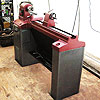I bought a new door for the back patio. The hinge locations on the door do not match the hinges on the frame. The door is steel. What is the best way to go about hanging that door to the original frame? Chisel out new hinge locations on the frame would be difficult I would guess. However, chiseling out new hinge spots on a steel door is not practical, so what is the best way to do this?
Thanks




 Reply With Quote
Reply With Quote






